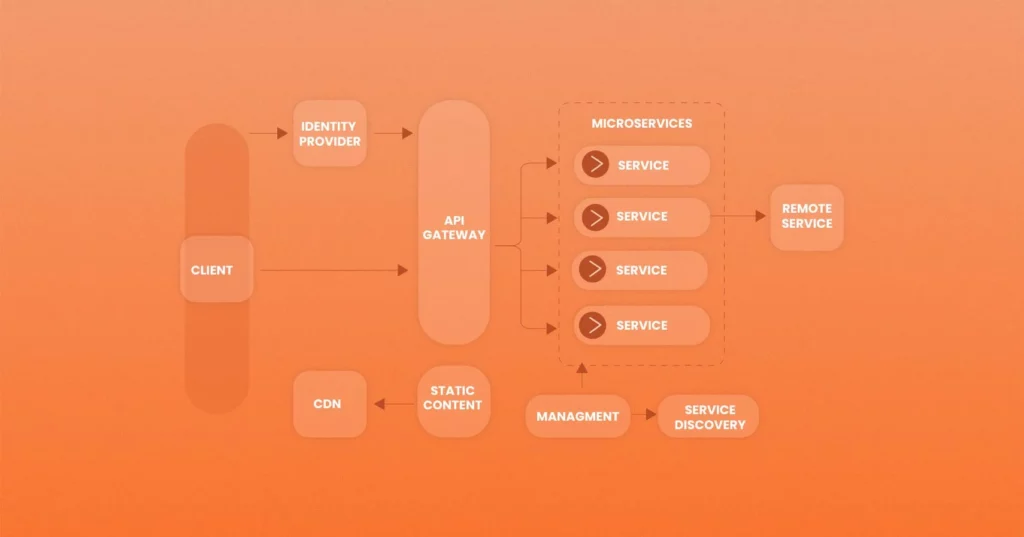TOP 20+ Microservices Interview Questions And Answers You Must Know [UPDATED 2024]

Table of content
What the term Microservice refers to?
The term Microservices can not be captured within one definition, but the well-known definition is that Microservice Architecture is an architectural style that structures an application as a collection of loosely coupled services. Each service operates by itself and interacts through lightweight, generally HTTP Resource-API protocols.
This service is rapidly being adopted by organizations in order to generate company solutions. With this functioning on simple modular services, the need for cloud solutions is increasingly expanding.
Microservices. It covers healthcare, banking, public administration, manufacture, retail, IT & telecommunications, medium & entertainment, production, etc. Its target audience includes investors, consultants, system integrators, and government organizations as well as suppliers of IT & technology solutions. Cognizant, IBM, Microsoft, Salesforce, and Software AG are some leading firms in this sector of expertise. By the year 2023 will know a big increase in the microservices’ architecture industry.
Here are the top 20 interview questions and answers that you must know if you are seeking a profession in this industry or getting ready for an interview.
TOP 20 Microservices Interview Questions and Answers
The microservices interview questions and answers included in this article brought to you by hiring managers and experts in the field. But, execute more in-deep research to widen the chance to ace your interview.
What is Microservices?
Answer: Microservices is an SDLC technique that builds huge programs as a collection of tiny functional modules, or more correctly. This functional module may be deployed, scaled, targeted, and interact with particular business objectives via standard protocols independently. Such modules may also be installed with various programming languages, their databases, and deployed in various software settings. Every module is small and comprehensive in this respect.
What are the main features of Microservices?
Answer: The key elements of microservices are as follows:
- Multiple deployable components for individual applications.
- Business Capabilities Service Distribution.
- Decentralize data management.
- DevOps Delivery.
- Independence of technology.
- Component Hidden Complexity to prevent unwanted dependencies in the microservice.
What are the main components of Microservices?
Answer: For Microservice Architecture the basic components are:
- Clustering and Orchestration Containers.
- IaC [Code Design Infrastructure].
- cloud infrastructure. cloud infrastructure.
- Gateway for the API.
- Service Bus Enterprise.
- Delivery of service.
How does a Microservice Architecture work?
Answer: The app is under a microservice architecture into many modules that do all the precise standalone task independently:
- They split into different modules, each of which has a different purpose.
- It can distribute or disperse in clouds and data centers.
- Perform each module as a stand-alone service/process to change, update or remove without interrupting the other program.
- An application may expand with its requirements under microservice architecture.
What are the fundamental characteristics of a Microservices Design?
Answer: These are the fundamental characteristics of Microservices:
- Services divided into business functions and arranged around them.
- Several development teams are managing and controlling separate modules.
- Decentralized framework. Decentralized framework.
- Entertainment by individual development teams of the relevant components.
- Different databases may keep separate components.
- Modules deploy independently in a Microservice Architecture. The whole architecture is like an independent unite. It does everything by itself without interrupting it.
- Real-time application monitoring.
What are the main challenges in Microservice Deployment?
Answer: Microservice’s issues might be both technical and functional.
The key obstacles from the point of view of business are:
- Need big investment.
- Installation of heavy infrastructure.
- Excessive overhead management planning.
- Selection and upkeep of personnel.
From a technical standpoint:
- Communication across the application’s many microservices.
- Automation component.
- Maintenance application.
- Management of configuration.
- Overhead heavy operation.
- Challenges for deployment.
- Challenges testing and debug.
What are the advantages and disadvantages of Microservices?
Answer:
Advantages:
- Scalability improved.
- Fault isolation
- Complexity located.
- The agility increased.
- Simplified Maintenance and Debugging.
- Better contact with business users amongst developers.
- Smaller teams for development.
- Improving scope for upgrading technologies.
Disadvantages:
- All in all, complicated.
- Exact pre-planning is necessary.
- It is difficult to compute modular dependencies.
- Less control over apps from third parties.
- It is difficult to track modular interdependencies.
- More chances for hostile interference.
- End-to-end testing is complicated.
- Challenges for deployment.
What are the different strategies of Microservices Deployment?
Answer:
● Multiple Service Instance per Host: Run the program on single/multiple physical/virtual-hosts with single or multiple service instances.
● Host Service: Run a service instance per host.
● Service Instance per Container: Run each instance in its container.
●Serverless Deployment: Package and upload the service to the Lambda function as a ZIP file. Lambda is a stateless service that runs enough microservices to process all requests automatically.
What is Domain Driven Design?
Answer: Domain-driven design is an architectural approach based on the concepts and ideas of object-oriented analysis. It helps to build a complicated system by linking the software system components to a constantly changing system. Three essential concepts underpin the domain-driven design:
● Concentrate on the basic domain and field logic.
● Basis complicated designs for domain models.
● To develop the application model and tackle developing domain-related problems, work often with domain experts.
What is Spring Boot Microservices?
Answer: Spring Boot is an open-source Java-based framework that offers its developers a great platform to build a stand-alone spring application for production. It is easy to grasp, improves productivity, and decreases time to create. It configures a claim automatically on the basis of the new application dependencies.
What is the difference between Monolithic, SOA, and Microservices Architecture?
Answer:
● Monolithic Architecture: diverse application components, including UI and business logic, combine into a single platform or program in this kind of architecture. Data access layer.
● SOA (Service Oriented Architecture): Individual components loosely linked in this design and provide a separate role. Service providers and customers have two main functions. Modules combined and reused in SOA types, which makes them versatile and confident.
● Microservices Architecture: This is a sort of SOA that constructs and combines a number of independent components to produce an app. The APIs incorporate these components. This strategy focuses on company objectives and capacities, and provides high levels of agility, meaning that each part of the app can work separately.
Difference between Cohesion and Coupling?
Answer:
● Coupling: This is module A’s connection to module B. Every module separates from other modules. The best connection is a loose interface coupling.
● Cohesion: It is the connection between 2 or more module components. If a module has high cohesiveness, that indicates the module can accomplish a certain job alone without communicating with other modules with maximum efficiency. High cohesiveness enhances the functionality of a module.
What is Distributed Transaction?
Answer: The distribution transaction consists of two or more network hosts. Transactions managed by a transaction manager who is in charge of transaction development and management. If there is more than one pair involved in the transaction, transaction managers of each pair interact amongst themselves utilizing subordinate or superior relations.
The resource manager handles the same approach that coordinates transaction atomicity and isolation with the distributed transaction coordinator.
In a clear sentence explain end-to-end Microservices Testing?
Answer: It is a tested technology for testing a business transaction through the whole course of an application. As several components involved with the design of microservices, these tests can cover gaps while a unit is in the test It also ends trust, guarantees that the network settings properly set up, and supports the development of microservices.
What is a container:
Answer: Containers in the virtualized operating system separated workload environments. It comprises a program and all the necessary functions and files. All box is an isolated environment and is not physically connect to the program, giving a viable application option.
What is Contract Testing?
Answer: Contract testing verifies that the microservice architecture’s explicit and implicit contracts function as planned. There are two prospects – the consumer and the supplier. The consumer is the entity that uses the microservice, while the supplier is the entity that provides the service. The services function in accordance with set standards and this is 100% via contract testing.
What is OAuth?
Answer: OAuth stands for an Open Standard Authorization Protocol or framework which provides an indication that servers and services without connecting with the original connected, single login credential can securely provide authorized access to their assets. Also, this is the security authorization of a third-party, user agent.
In simple sentences explain what can you derive/understand from Conway’s Law?
Answer: Melvin Conway suggested this theory in the late 1960s. This law indicates that ‘organizations that create systems must develop duplicates of these organizations’ Communications structures.’ The team of people that create a piece of software finally makes the design according to their point of view.
Question 18: Explain to me how does Docker helps in Microservices?
Answer: As we know, microservices are independent units that execute just one business function such that each unit may be like an app on its own. The environment for application development and application deployment will differ in various ways. This leads to problems with deployment. Docker provides the program with a static background, which avoids problems in deployment. It’s actually a tool to containerize. It lowers the overall costs and launches many thousand microservices on the same server. Docker guarantees that an application microservice runs in its own environments and is fully independent.
What is Canary Releasing?
Answer: Canary releasing is a strategy wherein new versions of the software are out by upgrading to a small subset of users before rolling it out to the full infrastructure. It is like the canary release technique in charcoal mines that alerts mining companies to alarming amounts of hazardous gas.
Explain what is the role of RESTful APIs in Microservices?
Answer: The idea of a microservice is about which all its component services need to communicate to perform their business functions. This requires an interface for each microservice. RESTful APIs provide a logical model for the construction of these interfaces. It relies on the Web’s open principles of networking. It, so, acts as the most important microservice enabler.
Extra tips on how to ace your microservices interview questions:
It is true that microservices have an extra layer of complexity as Junit, but, let us be serious, microservices interview questions are as complicated as any other job interview questions. Question-out of microservices requires thorough mental and physical preparation on both sides. Besides, pay extra attention to your resume because it needs to be special and to the point. To beat the other candidates you have to do what they don’t.
Spring java interview questions are like a branch of microservices interview questions that need to understand how things operate in order to be capable to answer correctly. I believe you know that “repetition makes perfect” but I said “preparation makes perfect”That is to say, exert a massive effort in preparation and you will nail your microservices interview questions. So, to ace your spring java interview questions you need to master how java architect interview question works. YOU GOT THAT.

Elias Oconnor
Senior Copywriter